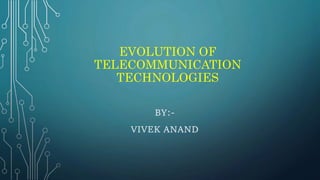
EVOLUTION OF TELECOMMUNICATION TECHNOLOGIES.pptx
- 2. FIRST GENERATION(1G) Most popular 1G System during 1982 at Bell labs. Also known as Advanced Mobile Phone System(AMPS). The idea here was to divided the geographical Areas into cells. Frequency:-850MHZ Bandwidth:-2.4KBPS Speed:-2Kbps Access System:-FDMA. Switching technique:-Circuit Switching. Core Network:-PSTN(public switched telephone network).
- 3. SECOND GENERATION(2G) Most popular 2G System during 1991 at Finland. Based on GSM(Global System for Mobile). Deliver data rate of 5kB/s. Frequency:-900 and 1800MHZ Bandwidth:-30-200KHZ Technology:-GSM. Speed:-64Kbps Access System:-TDMA,CDMA. Switching technique:-Circuit Switching for voice and PS for data. Core Network:-PSTN(public switched telephone network).
- 4. FIRST GENERATION(2.5G) Most popular 2.5G System during 1995. Based on GPRS(General Packet Radio Serving ). Data transfer at the rate of 160kb/s. Frequency:-Same as 2G Bandwidth:-384Kbps Technology:-GPRS. Speed:-115kbps Access System:-CDMA. Switching technique:-Packet Switching. Core Network:-PSTN(public switched telephone network).
- 5. SECOND GENERATION(2.7G) Most popular 2.7G System during 1997. Deliver data rate of 500kB/s Using same GPRS Infrastructure. Uses 8PSK Modulation. Frequency:-same as 2G Technology:-GSM. Speed:-239kbps Access System:-CDMA. Core Network:-PSTN(public switched telephone network).
- 6. THIRD GENERATION PARTNERSHIP PROJECT(3GPP) Most popular 3G was on developing phase ,using W-CDMA. During Year 1999,UMTS(Universal mobile telecommunication system). In year 2000, Governing bodies formed 3GPP standard and it’s govern by ITU-R(International Telecommunication Union Radio communication Sector.
- 7. THIRD GENERATION (3G) In year 2000. Release 99. The goal was to provide data rate of minimum 2mbits/sec for stationary and 384kb/s for moving user. Based on spread spectrum radio transmission technology. Data transfer at the rate of 3megabits/s. Frequency:-800,850,900,1700,1900MHZ Bandwidth:-5MHZ Technology:-W-CDMA. Speed:-2Mbps Access System:-CDMA. Switching technique:-Packet Switching. Core Network:-Packet Network.
- 8. RELEASE Release 4 (2001):- Provide efficient use of IP. This was the key Enabler for 3G HSDPA(High speed downlink packet Access). Release 5 (2002):- It include core of HSDPA. Provide reduced delay for downlink. Provide data rate of 14MB/s. Release 6 (2004):- This include core of HSUPA(High speed uplink packet Access). Reduce latency (delay). Provide uplink data rate of 5.7mb/s.
- 9. Release 7 :- This 3GPP standard include downlink MIMO operation as well as support higher order modulation(to 64 QAM). In year 2007 HSPA+(Evolved high speed packet Access has been introduced in 3GPP Release 7. Provide data rate up to 28mbits/s in downlink. Provide data rate up to 11mb/s in uplink. Release 8(was completed on 2007):- • Reduced delay, for both connection establishment and transmission latency. • Increased user data throughput. • Increased cell. Release 9 was deployed by organization in 2009
- 10. FOURTH GENERATION(4G) Most popular 4G System during 2010 . Deliver data rate of 150MB/s download and 50 Mbit/sec for upload. Frequency:-700MHZ,1.7/2.1GHZ,2.3,2.5GHZ Bandwidth:-20MHZ Technology:-LTE,WIMAX. Speed:-1Gbps Access System:-CDMA. Switching technique:- Packet Switching. Core Network:-Internet.
- 11. SUBSEQUENT RELEASE FROM( RELEASE 10-RELEASE 13) MULTIPLE SERVICES ARE:- Multicell HSDPA. HETNET Carrier Aggregation Massive MIMO
- 12. FIFTH GENERATION(5G) Most popular 5G System during 2018. Based on OFDM(Orthogonal frequency division multiplexing). Deliver data rate faster then 4G. Frequency:-300GHZ Bandwidth:-40MHZ Technology:-MIMO. Speed:-10Gbps Access System:-OFDMA. Switching technique:-Packet Switching . Core Network:-Internet.